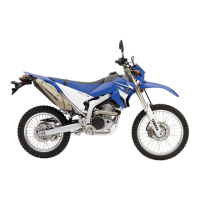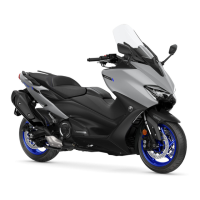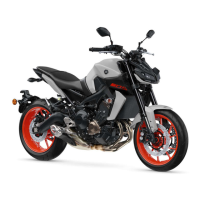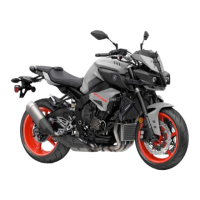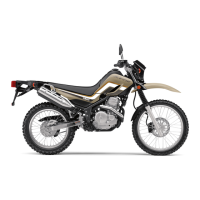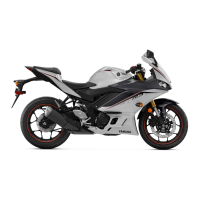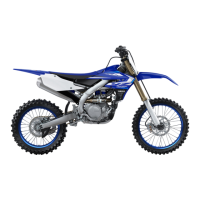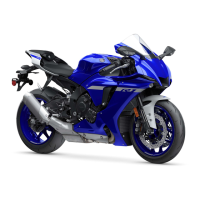Do you have a question about the Yamaha WR250R 2020 and is the answer not in the manual?
Explains symbols and notations like WARNING and NOTICE for hazard communication.
Details requirements for premium unleaded gasoline and octane rating.
Highlights critical warnings regarding vehicle operation and protective gear.
Illustrates the routing of emission control hoses for California models.
Warns about high-pressure nitrogen gas and potential explosion hazards.
Outlines owner's responsibilities for safe motorcycle operation and training.
Provides advice on visibility, intersections, blind spots, and maintenance.
Stresses the importance of helmets, eye protection, and protective clothing.
Warns about the dangers of carbon monoxide from engine exhaust.
Advises on proper cargo loading to maintain stability and avoid accidents.
Discusses potential safety hazards from aftermarket parts and modifications.
Identifies major components and their locations on the left side of the motorcycle.
Identifies major components and their locations on the right side of the motorcycle.
Shows the layout of handlebars, levers, and dashboard instruments.
Explains the operation of the ignition, lighting, and steering lock functions.
Describes the function of various dashboard indicator and warning lights.
Details the features and operation of the digital display unit.
Explains operation of dimmer, turn signal, horn, engine stop, start, and clutch levers.
Describes operation of shift pedal, front brake lever, and rear brake pedal.
Instructions for fuel tank cap and fuel system safety precautions.
Information on catalytic converter, seat, and helmet holder functions.
Details for adjusting front fork damping and shock absorber settings.
Information on EXUP system and sidestand operation and safety.
Lists essential checks before riding the motorcycle for safety and condition.
Step-by-step guide for starting the motorcycle's engine.
Explains gear shifting and guidelines for the engine break-in period.
Safe procedures for parking and general riding advice.
Information on the included tool kit and its use for maintenance.
Schedules for emission control and general maintenance tasks.
Procedures for removing and reinstalling body panels for maintenance access.
Guide on checking spark plug, engine oil, and coolant condition.
Steps for cleaning air filter and spark arrester for engine performance.
How to adjust idling speed, throttle play, valve clearance, and tires.
Adjusting clutch/brake levers, checking pedals, and lubricating cables.
Checking brake pads, fluid levels, changing fluid, and drive chain slack.
Lubricating drive chain, cables, levers, pedals, and sidestand.
How to check front fork, steering, and wheel bearings.
Information on battery maintenance, charging, and fuse replacement.
Steps for replacing headlight, turn signal, and license plate bulbs.
Procedures for removing wheels and general troubleshooting guidance.
Steps for diagnosing and addressing engine overheating issues.
Advice on cleaning and caring for matte finished parts.
Guidelines for washing the motorcycle to prevent damage.
Instructions for short-term and long-term motorcycle storage.
Technical specifications for the motorcycle's physical dimensions, weight, and engine.
Information on fuel capacity, ignition, battery, lighting, and brake systems.
Specifications for tires, wheels, brakes, and suspension systems.
Location and importance of vehicle, engine, and key identification numbers.
Procedure for reporting vehicle safety defects to NHTSA and Yamaha.
Information on noise laws and a template for recording maintenance history.
Details the manufacturer's limited warranty terms, exclusions, and customer responsibilities.
Addresses common customer inquiries regarding the motorcycle warranty coverage and responsibilities.
Information on obtaining warranty service and contacting Yamaha for support.
Information on optional extended warranty plans, coverage, and benefits.
| Displacement | 250cc |
|---|---|
| Bore x Stroke | 77.0mm x 53.6mm |
| Compression Ratio | 11.8:1 |
| Fuel System | Fuel Injection |
| Ignition | TCI: Transistor Controlled Ignition |
| Final Drive | Chain |
| Front Tire | 80/100-21 |
| Rear Tire | 120/80-18 |
| Seat Height | 36.6 in |
| Wheelbase | 55.9 in |
| Rake (Caster Angle) | 26.7° |
| Trail | 4.4 in |
| Ground Clearance | 11.8 in |
| Fuel Capacity | 2.0 gal |
| Engine Type | Liquid-cooled, DOHC, 4-stroke, single cylinder |
| Transmission | 6-speed; multiplate wet clutch |
| Front Suspension | Inverted fork, fully adjustable, 10.6-in travel |
| Rear Suspension | Single shock, fully adjustable, 10.6-in travel |
| Front Brake | Single disc, 250 mm |
| Rear Brake | 230mm hydraulic disc |
| Wet Weight | 295 lb |
